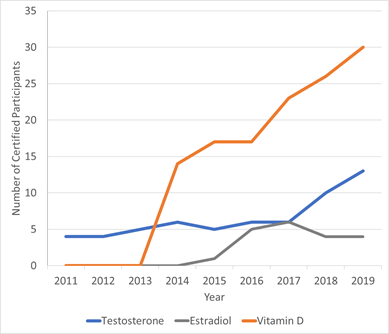Key points
- Healthcare professionals order more than 14 billion laboratory tests annually in the United States and use the results for many medical decisions.
- To ensure quality of care, laboratory measurements must be accurate and reliable.
- CDC Clinical Standardization Programs ensure many tests can be confidently used for patient care and research.

Boosting confidence in test results
Clinical tests used in patient care that are standardized by CDC Clinical Standardization Programs show greater accuracy than tests that are not standardized.
Data from proficiency testing programs have shown that CDC-standardized laboratory tests used in patient care are more accurate than nonstandardized tests.
Supporting population health
Tests that are standardized by CDC also support the correct assessment of trends in population health.
For example, the National Health and Nutrition Examination Survey provides representative data about high cholesterol in the U.S. population. The survey can help tell whether activities to reduce cholesterol are effective. CDC has been standardizing blood lipid tests used in the survey for many years, helping public health officials detect population trends in cardiovascular risk with confidence.
Saving millions in health care costs
The annual benefit attributable to the CDC Lipids Standardization Program alone is approximately $338 million, at a program cost of $1.7 million, according to a study in Preventing Chronic Disease. Researchers estimated the value of reduction in heart disease deaths resulting from various treatments dependent on lipids testing. The study built in conservative assumptions of 0.5% of cholesterol-related benefits attributable to the programs and a $50,000 value per life-year.
Informing the professional community
CDC ensured that vitamin D measurements in the landmark VITamin D and OmegA-3 TriaL study were accurate. Findings provided valuable information about the health effects of taking vitamin D supplements on diseases such as cancer.
CDC ensured that testosterone measurements in the Testosterone Trials study were accurate and reliable. The findings from this study helped scientists prepare clinical practice guidelines.
Ensuring timely solutions
CDC continuously monitors the analytical performance of participants in their different programs to enable timely corrective actions and avoid problematic changes in performance. As an example, data from CDC's Lipids Standardization Program helped identify a problem with accuracy of cholesterol measurements from a major test manufacturer. We provided technical assistance to the manufacturer to improve the accuracy and reliability of its measurements, which account for nearly 25% of the cholesterol tests done in the United States. This early detection and intervention helped prevent misdiagnosis and misinterpretation of results for an important health indicator.
Solidifying test results
CDC provides critical information about reference materials and methods to help with calibration. We apply unique procedures to characterize reference materials. These are used to produce the critical data manufacturers and researchers need to calibrate tests correctly—and reduce variability in results.
Collaborating to improve diagnoses
CDC collaborates with academic researchers around the world. Successful projects include:
- The development of better pediatric reference intervals or "normal ranges." As a first step, CDC collaborated with the American Association of Clinical Chemistry to conduct a thorough review of existing reference intervals and develop a strategy to address their limitations. Findings are published in JAMA Pediatrics.
- Collaboration with the Partnership for the Accurate Testing of Hormones to establish reference intervals for testosterone in men that were recommended by an Endocrine Society Clinical Practice Guideline and are now used in clinical practice.
- Collaboration with the National Polycystic Ovary Syndrome Association to standardize testosterone testing for women and children to improve diagnoses of increasingly common endocrine disorders in women, such as polycystic ovary syndrome and certain cancers.
- Collaboration with the Partnership for the Accurate Testing of Hormones to define reference intervals for estradiol in postmenopausal women that will improve diagnosis of cancer and treatment of menopausal symptoms.
- Investigation of the impact of lipoprotein(a) variants on measurement accuracy of tests used in patient care. Information obtained from this research helps to assess cardiovascular disease risk more reliably.
- Collaboration with the National Cancer Institute to measure blood levels of different hormones in women with certain cancers. This research will help identify women at risk for cancer.
Increasing capacity worldwide
We help national and international organizations such as the following to establish reference laboratories using the CDC reference methods:
- Cholesterol Reference Method Laboratory Network
- International Federation of Clinical Chemistry
- Joint Committee for Traceability in Laboratory Medicine
- American Association for Clinical Chemistry
- Korea Disease Control and Prevention Agency
- Philippines Association of Medical Technologists
- Sociedad Boliviana de Bioquimica Clinica
We also assist agencies such as the following with reference material development and characterization to ensure global availability of critical reference materials:
- National Institute of Standards and Technology
- National Institute of Biological Standards and Control
- Laboratoire national de métrologie et d'essais
- European Commission – Joint Research Centre
